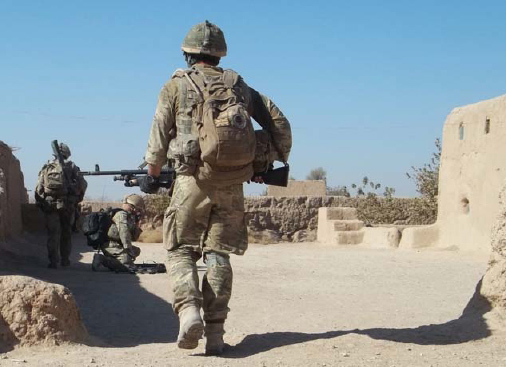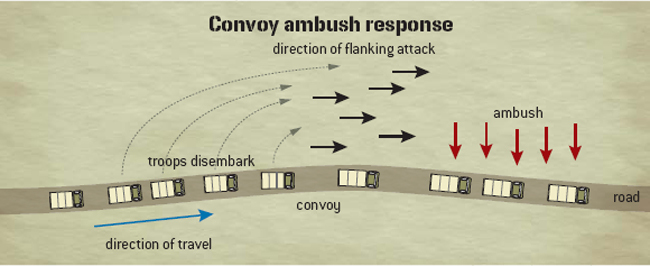Another advantage to the attacker is that he has as long as it takes to make his move – where there is a threat of ambush you have to protect every convoy tying up valuable resources permanently while the terrorist might not even be in the vicinity. You might send a convoy along a road every week for a year, tying up all manner of defensive assets, and never be attacked once. Or just the once. But you never know – this is the constant advantage of the insurgent position.
So what can you do to keep your convoys safe? Well, as ever, the answer depends on several factors which interrelate. Chief amongst them are the assets at your disposal, the assets at the disposal of the enemy and the type of country you are driving through.
Friendly assets
Aircraft: Helicopters or rapid response fixed-wing aircraft are the most effective type of protection for a convoy. It is not that they prevent an attack, rather that they ensure the enemy are killed and don’t do it again. With modern facilities for target acquisition, such as infra-red cameras, it is difficult for the enemy to escape unless they are in very mountainous or heavily wooded country. You should avoid taking a convoy through such areas when you can. But, of course, you often don’t have a choice.
If choppers fly along the course of the convoy, clearing the ground in advance, the enemy are going to be picked up before they make their move or, failing that, as soon as they open fire. At this point the choppers bring overwhelming firepower to bear and the attackers are liquidated. With fixed wing you get a similar outcome but the aircraft would be on call and strike the enemy once they had been detected by the sensor aircraft.
The trouble is that a convoy can be on the road for days at a time and to be of any use the aircraft have to be available round the clock, or at least when the convoy goes through trouble spots. Then there may be a hundred convoys without a hit but all those assets are tied up. The terrorist wins without firing a shot or even being there.

Foot patrol through an Afghan village 2010 – waiting to be ambushed. (Photo courtesy Tom Blakey)
So, because of the cost in assets employed, aircraft are usually not available to guard your convoy unless the enemy are very likely to attack and the ground is particularly difficult. In this case an effort is usually made to move as much as possible in one go – a very big convoy.
In their war with Afghanistan (1979–89) the Russians had exactly this problem. The only way to protect their convoys as they travelled through the mountain passes was to use helicopters. Someone supplied anti-aircraft missiles to the Afghans and this made life difficult for the Russians. They lost a great many men and helicopters. Actually, the Americans shipped the Stinger missiles to Pakistan from where they were trucked to the border and a Dutch friend of mine took them into Afghanistan on the backs of camels. Like Laurence of Arabia with tulips.
Ground forces: When you are travelling in convoy through open country a useful way to prevent a surprise ambush is the ‘Leading V’ formation, also employed in infantry manoeuvres and mentioned earlier. In this case it can consist of infantry or even armour.

The principle of the Leading V is that the screen catches the ambushers in the flank, at their point of weakness, rather than providing the target to their front which they are expecting.
Where the ground makes a Leading V impossible, a useful second best is to send patrols out ahead to take possession of peaks and outcrops thus giving them the advantage of height and position over potential ambushers.
Unfriendly assets
Almost any weapon can be used to ambush you but each has its own features, advantages and disadvantages to both you and the user. Direct fire weapons such as small arms and RPGs require the attackers to get up close and personal. This reduces their chances of escape when they are pursued by a stronger force. Indirect fire weapons are less accurate and can be eliminated by friendly air power as they are traceable and slow to move. Command detonated munitions – IEDs – are always very unpleasant.
Country: Wherever possible you are going to plan your route so as to avoid likely or useful ambush positions. A long drive is better than going through a narrow pass in the mountains. Knowing the principles of ambush yourself, and you will after you have waded through the next section, you can read the ground and assess where an ambush would be most likely to be successful or where the attackers might have a good chance of escape. The main things to watch out for are close cover by the road, high ground or difficult terrain on the ‘attack side’ and an open ‘killing ground’ opposite to prevent your escape to cover.
Mines: Where there is a ditch or killing ground opposite an ambush it is likely to be mined so be aware and think before you jump in for cover.
Order of march
Travel well spaced to avoid both indirect fire from artillery and having all your vehicles come under fire from the same ambush party. If the trucks are well spaced a shell will only get one of them at worst and most likely it will miss altogether.

A well spread convoy is also a threat to the ambushers because when one part comes under fire the troops in the remaining vehicles may be able to dismount and attack the ambushers in the flank as per the drawing above. All vehicles must keep in contact by radio and line of sight. The rear-guard must keep a watch for stragglers and breakdowns. The mechanics must travel at the rear in order to repair or destroy breakdowns as appropriate.
REMEMBER:
A favourite tactic of the experienced ambusher is to immobilize the front and rear vehicles first to trap the remainder and cause them to bunch up. So whenever possible, a vehicle capable of clearing obstructions, including your own vehicles hit by fire, should travel near the front of the convoy.
CHECKPOINT AND SENTRY DUTY
These two are every soldier’s least favourite jobs so don’t think I haven’t hated every minute of them myself. Checking thousands of civilians through gates in the wire or night after night of vehicle checkpoints in the rain... You know the score. The thing is, manning checkpoints and doing sentry duty are in many ways amongst the most important jobs you can do. You are keeping people, very often your own mates, safe from attack by bullet and bomb. It has got to be done so let’s make sure we do it right shall we? And don’t think the SF beret will let you escape these duties either – you will get higher value targets to protect by checkpoint and in a small team the guard rotas are harsh.
Checkpoints
A checkpoint is usually set up static to either act as a deterrent and stop insurgents bringing bombs or guns into a secure area or mobile to catch insurgent operators and their equipment as they are moved around. In the following explanations I have ignored the technical issue of suicide bombers and the need to keep these at a distance as we covered this earlier. You will have to strike a balance in each theatre of operations between operational convenience and suicide bomber protection depending on the likelihood.
Static checkpoint: This is normally a permanent checkpoint on pedestrian or vehicle gateways in a perimeter fence or building entrance and manned by foot-soldiers. Your task here is to prevent the opposition bringing bombs, weapons or certain people into a certain secure area. Because the insurgents know it is there, the chances are they will not attempt to get through – providing you are seen to be doing your job carefully. All the people within the secure building or area are depending on you for their lives.